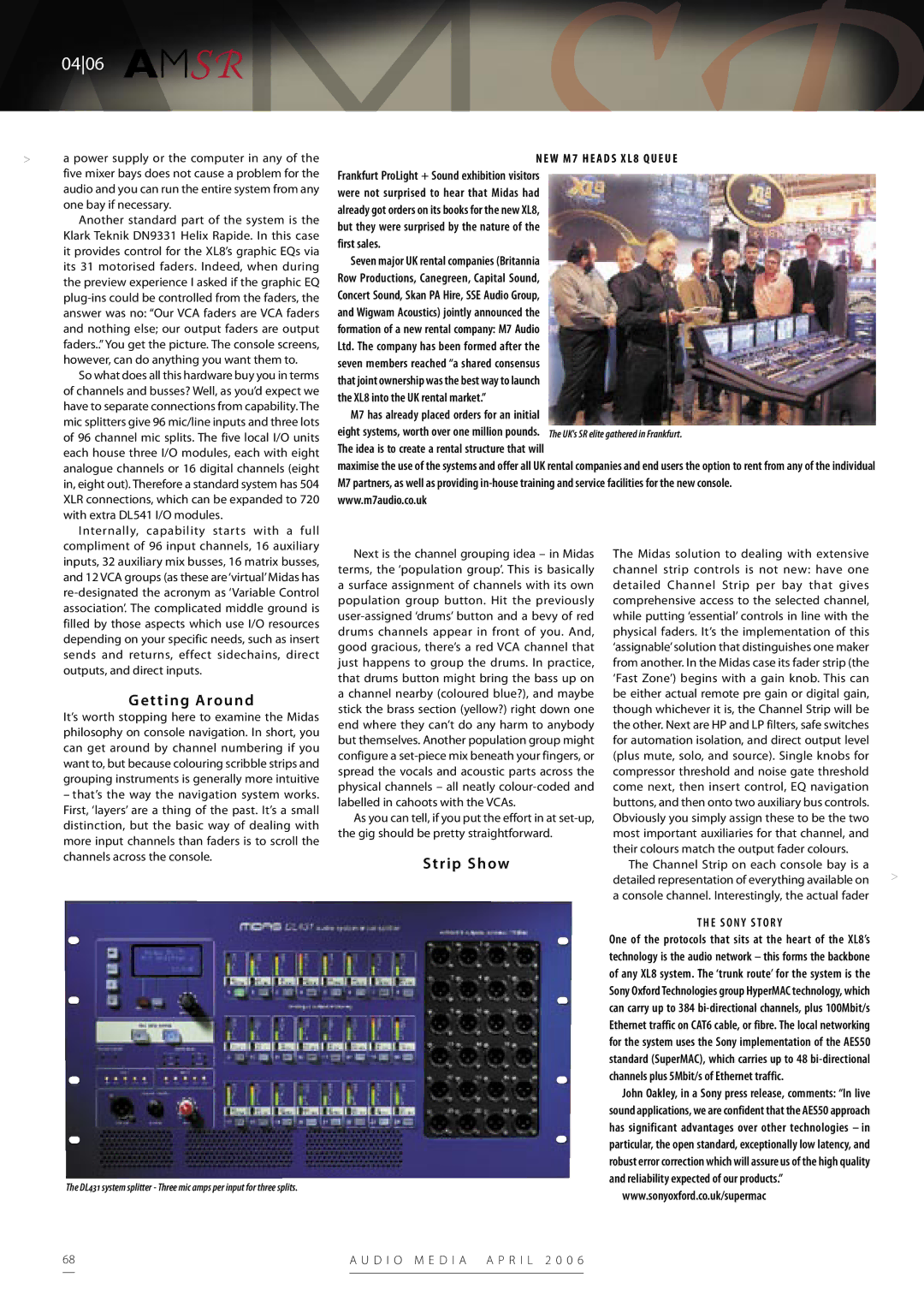
0406 AMSR
> | a power supply or the computer in any of the |
| five mixer bays does not cause a problem for the |
| audio and you can run the entire system from any |
| one bay if necessary. |
| Another standard part of the system is the |
| Klark Teknik DN9331 Helix Rapide. In this case |
| it provides control for the XL8’s graphic EQs via |
| its 31 motorised faders. Indeed, when during |
| the preview experience I asked if the graphic EQ |
| |
| answer was no: “Our VCA faders are VCA faders |
| and nothing else; our output faders are output |
| faders..” You get the picture. The console screens, |
| however, can do anything you want them to. |
| So what does all this hardware buy you in terms |
| of channels and busses? Well, as you’d expect we |
| have to separate connections from capability. The |
| mic splitters give 96 mic/line inputs and three lots |
| of 96 channel mic splits. The five local I/O units |
| each house three I/O modules, each with eight |
| analogue channels or 16 digital channels (eight |
| in, eight out). Therefore a standard system has 504 |
| XLR connections, which can be expanded to 720 |
| with extra DL541 I/O modules. |
| Internally, capability starts with a full |
| compliment of 96 input channels, 16 auxiliary |
N E W M7 H E A D S X L8 Q U E U E
Frankfurt ProLight + Sound exhibition visitors were not surprised to hear that Midas had already got orders on its books for the new XL8, but they were surprised by the nature of the first sales.
Seven major UK rental companies (Britannia Row Productions, Canegreen, Capital Sound, Concert Sound, Skan PA Hire, SSE Audio Group, and Wigwam Acoustics) jointly announced the formation of a new rental company: M7 Audio Ltd. The company has been formed after the seven members reached “a shared consensus that joint ownership was the best way to launch the XL8 into the UK rental market.”
M7 has already placed orders for an initial eight systems, worth over one million pounds. The idea is to create a rental structure that will
maximise the use of the systems and offer all UK rental companies and end users the option to rent from any of the individual M7 partners, as well as providing
www.m7audio.co.uk
inputs, 32 auxiliary mix busses, 16 matrix busses, |
and 12 VCA groups (as these are‘virtual’Midas has |
association’. The complicated middle ground is |
filled by those aspects which use I/O resources |
depending on your specific needs, such as insert |
sends and returns, effect sidechains, direct |
outputs, and direct inputs. |
Getting Around
It’s worth stopping here to examine the Midas philosophy on console navigation. In short, you can get around by channel numbering if you want to, but because colouring scribble strips and grouping instruments is generally more intuitive
–that’s the way the navigation system works. First, ‘layers’ are a thing of the past. It’s a small distinction, but the basic way of dealing with more input channels than faders is to scroll the channels across the console.
The DL431 system splitter - Three mic amps per input for three splits.
Next is the channel grouping idea – in Midas terms, the ‘population group’. This is basically a surface assignment of channels with its own population group button. Hit the previously
As you can tell, if you put the effort in at
Strip Show
The Midas solution to dealing with extensive channel strip controls is not new: have one detailed Channel Strip per bay that gives comprehensive access to the selected channel, while putting ‘essential’ controls in line with the physical faders. It’s the implementation of this ‘assignable’ solution that distinguishes one maker from another. In the Midas case its fader strip (the ‘Fast Zone’) begins with a gain knob. This can be either actual remote pre gain or digital gain, though whichever it is, the Channel Strip will be the other. Next are HP and LP filters, safe switches for automation isolation, and direct output level (plus mute, solo, and source). Single knobs for compressor threshold and noise gate threshold come next, then insert control, EQ navigation buttons, and then onto two auxiliary bus controls. Obviously you simply assign these to be the two most important auxiliaries for that channel, and their colours match the output fader colours.
The Channel Strip on each console bay is a detailed representation of everything available on > a console channel. Interestingly, the actual fader
T H E S O N Y S T O R Y
One of the protocols that sits at the heart of the XL8’s technology is the audio network – this forms the backbone of any XL8 system. The ‘trunk route’ for the system is the Sony Oxford Technologies group HyperMAC technology, which can carry up to 384
John Oakley, in a Sony press release, comments: “In live sound applications, we are confident that the AES50 approach has significant advantages over other technologies – in particular, the open standard, exceptionally low latency, and robust error correction which will assure us of the high quality and reliability expected of our products.”
www.sonyoxford.co.uk/supermac
68 | A U D I O M E D I A A P R I L 2 0 0 6 |
